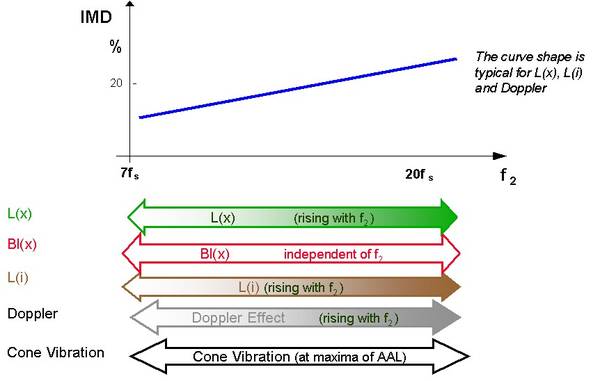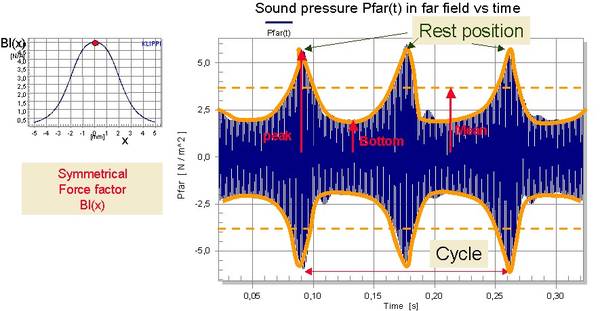I think I see the point, but then I am not sure I understand why you want loading in the first place?
I am currently working on a ring radiator, and it would be possible to make a version of that phase plug with spherical wavefront too.
I am currently working on a ring radiator, and it would be possible to make a version of that phase plug with spherical wavefront too.
I don't see how you could do it without the slots. I don't really care much about loading per se, I just see it as inevitable for getting the desired wavefront.
Dome tweeters in waveguides generally are easy to get to work well over a wide range. For example the Bliesma 34mm's in up to around 220mm wg covers around 1750 and then easily work up to 20k, all with wonderful dispersion.
Sure, but that's not a spherical wavefront anymore, as the dome moves axially, not radially. You are right that even an axially vibrating dome can work surprisingly well in a conical horn, however, I know that. Maybe just not so low in frequency as I woud like to get - as with large format compression drivers. That's what I'm aiming at.
Many will argue that 2. order is slightly more audible on average than 3. order. It will off course also depend on phase and other conditions, but both of them are also often a significant contributor to intermodulation distortion, but in a slightly different way. My personal experience is that 2. order tends to add a bit of brightness that is often not as pronounced with 3. order harmonics overtones.
In general, if the amount of odd harmonics is low, THD is usually low.
IMD is bandwidth and excursion related (among others) and as such much more of a problem for direct-radiating cone drivers than for compression-loaded smaller diaphragms.
Many modern so-called high-end tiny cone woofers that should cover 30-5000 Hz suffer from relatively high amounts of IMD despite relatively low THD.
IMD is the most troublesome type of distortion imo, but is often overlooked.
I can not see how probability density should apply to a causal system. Would you care to enlighten me on that?
PDF refers to the stats of the signal not the system. SInce any system can have input and output signal, the PDF can be applied to those.
IMD is the most troublesome type of distortion imo, but is often overlooked.
Please don't propagate the idea that IMD is any different than THD. They are both the direct result of a nonlinear system, but use different signals to test it. Any signal can be used in theory and it doesn't change the underlying nonlinearity of the system even though the outputs will be different for different signal.
Are you implying that the characteristics for audibility of IMD are the same (or similar) as those of THD?Please don't propagate the idea that IMD is any different than THD. They are both the direct result of a nonlinear system, but use different signals to test it. Any signal can be used in theory and it doesn't change the underlying nonlinearity of the system even though the outputs will be different for different signal.
You don't even need THD or IMD to describe the underlying nonlinearity, which is still only one and the same. THD and IMD are just numbers characterizing how this nonlinearity change a sine signal of particular level, or more of them superposed. Take music as the input signal - you don't have THD od IMD anymore, yet the nonlineary is still the same. It needs to be described in general by some other means other than those (meaningless) numbers.
Last edited:
IMD level is strongly dependent on the order of nonlinearity and energy distribution between the fundamental and overtones in the testing signal. The higher order of nonlinearity gives the higher level of IMD for the same testing signal. Thus, at certain conditions IMD level can exceed that of THD by 2-3 orders of magnitude (inspite that both IMD and THD are strictly related to the system nonlinearities). 🙂
Those adept in maths even see how intuitive the GedLee metric is in this sense. It might not seem like that on the first look but I can tell you, it is actually very intuitive formula, allowing to understand what it is all about - how strong factor the "smoothness" of the nonlinearity is. After understanding this formula, you will forget about THD or IMD forever.
Last edited:
.. Take music as the input signal - you don't have THD od IMD anymore,...
I think we understand what you mean but the expression is not correct of course. HD and IMD is there all along with the music, created by the non-linearity.
//
You don't have those numbers anymore as the levels are continuously changing. That's what I meant.
Please don't propagate the idea that IMD is any different than THD. They are both the direct result of a nonlinear system, but use different signals to test it. Any signal can be used in theory and it doesn't change the underlying nonlinearity of the system even though the outputs will be different for different signal.
Neumann:
"Like harmonic distortion, a lower intermodulation distortion results in a more transparent, cleaner sound quality. Unlike harmonic distortion, intermodulation distortion levels do correlate well with perceived sound quality, the lower the better."
That seem plausible!
Do real scientific research exist?
Do IM manifest itself like a noise (trail) on more complex music?
//
Do real scientific research exist?
Do IM manifest itself like a noise (trail) on more complex music?
//
🙄


p.s.
I also have mathematical studies on nonlinear distortion (THD vs IMD), but they are in Russian.
Do real scientific research exist?
//


p.s.
I also have mathematical studies on nonlinear distortion (THD vs IMD), but they are in Russian.
Last edited:

The figure above illustrates the interpretation of the intermodulation distortion measurement using a fixed low frequency tone f1 and a high frequency tone f2 which is varied over the audio band (“voice tone sweep”). While the stiffness nonlinearity can not produce significant intermodulation, the other nonlinearities generate wide-band distortion which can not be detected by a harmonic distortion measurement.

The figure above shows the intermodulation of a high frequency tone f2 by a low frequency tone f1 caused by a nonlinear force factor Bl(x) characteristic. If the voice coil is at the rest position x=0 the instantaneous value of Bl(x=0) is maximal and generates the peak in the envelope of the sound pressure signal. For a negative and positive peak excursion, the Bl-value becomes minimal generating the bottom values of the envelope. The temporal variation of the envelope of the high-frequency generates a fluctuation and roughness in the perceived sound.
Last edited:
So, Kees, .....what do you actually want?
What I would love to be the outcome of this thread, with all these bright minds united, is a waveguide with a custom phase plug ( maybe as a replacement in an excisting compression driver) which has a great constant directivity behaviour for at least 4 octaves without using diffraction mechanisms where the bias is much more put on sound quality instead of maximum output compared with excisiting solutions ( phase plug much more focussesd on great wavefront coherence than high compression/ cheap to manufacture)
IMHO, for this goal is is nessecary to;
1- do all simulations in a finite baffle, since this matters a lot, not only for the lower frequencies,
2- to simulate the complete system starting with the phasing plug,
3- build and test promising designs to validate and improve the model.
This is, in my opinion, all possible with the people who are contributing here.
I apologize again for my rant, I just really hoped that this would happen here, with the end result that something special would come out. ( dont get me wrong, Marcel's work is awesome and I stated my respect for the work.of dr Geddes many times before, I just really liked the idea of great group effort with awesome outcome)
I completely understand if you disagree with my opinion and rather discuss all horn/waveguide designs of the past 100 years and the audibillity/measureabillity (?) of distortion, it's a hobby a after all, and meant to be enjoyable.
Kind regards,
Kees
Last edited:
- Home
- Loudspeakers
- Multi-Way
- Acoustic Horn Design – The Easy Way (Ath4)